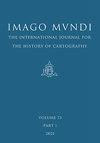Where Caciques and Mapmakers Met: Border Making in Eighteenth-Century South America
IF 0.5
4区 历史学
Q4 GEOGRAPHY
Imago Mundi-The International Journal for the History of Cartography
Pub Date : 2022-01-02
DOI:10.1080/03085694.2022.2044188
引用次数: 0
Abstract
modern Hawaii, everyday spoken conversation is conducted using a blended approach in which an expanding range of Hawaiian words is easily included. This is particularly true in scholarly works, where inappropriate Western terms have been displaced by Hawaiian words. Thus Mapping Abundance incorporates a considerable vocabulary that will be unfamiliar to readers who do not live there. And that is for the better. As I argued in Surveying the Mahele (Honolulu, Editions Limited, 1994), it is erroneous to talk about Hawaiian land practices using terms from Western culture. The same is true of other aspects of culture. Western terminology alone is not sufficient to discuss Hawaiian traditions and practices. The terms malama and kuleana, for instance, represent complex concepts of responsibility for care of the land. Geographically, this reintroduction of Hawaiian terminology is particularly relevant. For instance, fifty years ago, the commonly understood definition of the term ahupuaʻa, a basic land unit, was a pie-shaped unit that ran from mountain top to the sea. Today, people are far more cognizant that ahupuaʻa and related terms such as ʻili and kuleana refer to a much more subtle concept of land tenure. With a larger number of people now being fluent in Hawaiian, nuances are being teased out of the language and applied to discussions of Hawai’i’s past and future. Fujikane, of the University of Hawaii, offers insight into how traditional, indigenous descriptions of landscapes found in chants are fuelling efforts by Hawaiian activists to increase productivity (in a broad sense) by displacing Western practices with ones derived from native knowledge. Fujikane shows that Hawaiian mythological chants contain specific and reliable geographical descriptions and thus constitute legitimate forms of ‘cartographies’ or ‘geographies’ as she labels them. In several cases she illustrates how such native geographical knowledge can be displayed with Western cartographical techniques, thus making it useful for restoring past practices, protesting controversial actions and addressing legal challenges in court. Within the context of academic studies of the history of cartography, Hawaii is something of an outlier. It was not until the 1830s that any Western-based mapping was done by Hawaiians themselves, and earlier mapping by non-Hawaiians was not undertaken for the benefit of the people of Hawaii (Fitzpatrick, Early Mapping of Hawaii, 1986). When the communal system of land ownership was replaced with a Western-styled system of private landownership in the 1840s and 1850s, much knowledge of the land-use practices of traditional Hawaii was lost. From 1870 to 1898, the Hawaiian Government Survey conducted a sophisticated mapping operation that documented a considerable amount of the localized knowledge that had survived until that time. Mapping Abundance is a testament to the excellent work academics and activists are doing in tapping traditional literature to enhance the knowledge about ancient Hawaiian land tenure and to better understand the successful ways in which early settlers of the islands worked in harmony with the varied landscapes of the islands. © Gary L. Fitzpatrick Library of Congress (retired), Washington, DC https://doi.org/10.1080/03085694.2022.2044187仙人掌和地图制作者相遇的地方:18世纪南美洲的边界制作
本文章由计算机程序翻译,如有差异,请以英文原文为准。
求助全文
约1分钟内获得全文
求助全文
来源期刊
CiteScore
0.20
自引率
0.00%
发文量
32
期刊介绍:
The English-language, fully-refereed, journal Imago Mundi was founded in 1935 and is the only international, interdisciplinary and scholarly journal solely devoted to the study of early maps in all their aspects. Full-length articles, with abstracts in English, French, German and Spanish, deal with the history and interpretation of non-current maps and mapmaking in any part of the world. Shorter articles communicate significant new findings or new opinions. All articles are fully illustrated. Each volume also contains three reference sections that together provide an up-to-date summary of current developments and make Imago Mundi a vital journal of record as well as information and debate: Book Reviews; an extensive and authoritative Bibliography.

 求助内容:
求助内容: 应助结果提醒方式:
应助结果提醒方式:


